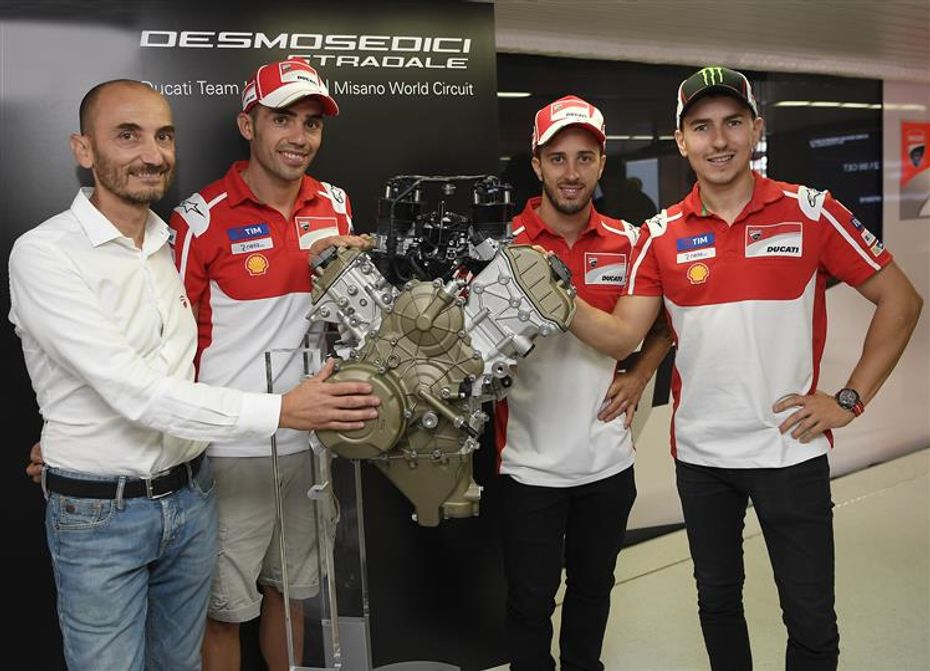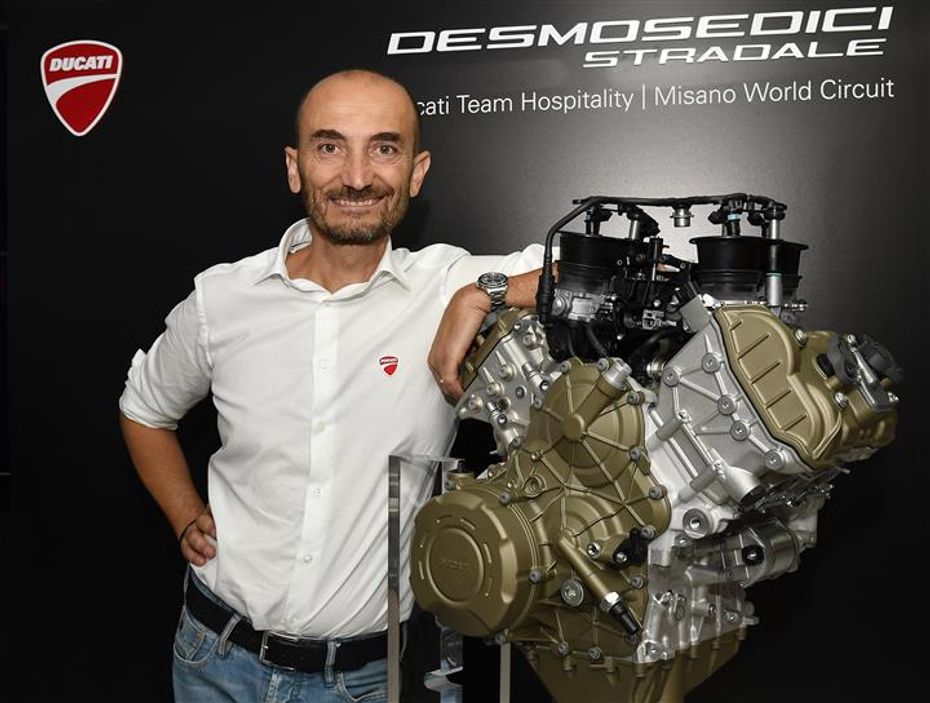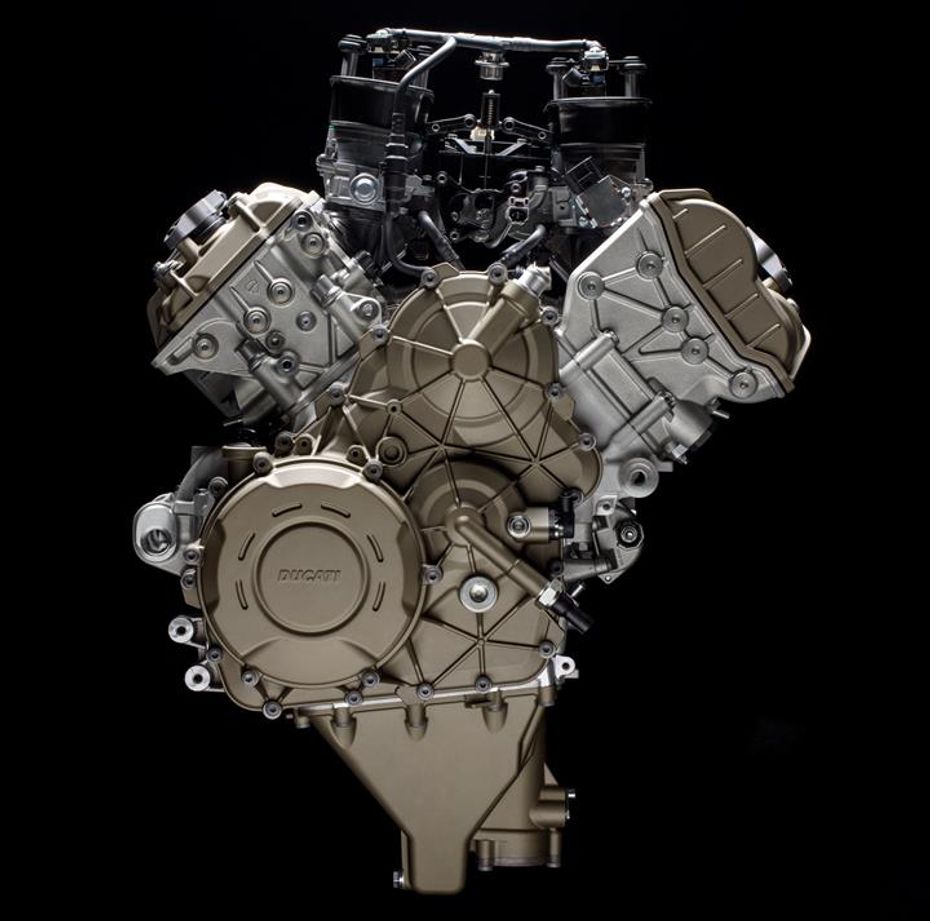
The 2025 Ather 450 Put Through An Insane Track Attack Challenge...
- Jan 4, 2025
- Views : 94730


The character of just about every Ducati has been dictated by their 90 degree twin-cylinder engines. The engines dictated how the bikes rode, and how the the chassis’ were built around them. Coupled with Ducati’s desmodromic valve-train the L-twin has reached some mighty highs, as seen on the 215PS Panigale Superleggera.
However, the limit of the L-twin architecture was approaching. Something more powerful, yet more efficient was required. Team Ducati in collaboration with the racing team were busy designing the core of the new breed of Ducatis. A lot of the new Desmosedici motor is built around needs of going racing. Now WSBK has limited done away with the special 1200cc limitation for V-twin engines, with a uniform 1000cc cap irrespective of architecture.
With the need for more power from a smaller engine it didn’t come as a surprise as the V4 is closer in character to Ducati’s L-Twin and Ducati already had many years of experience from racing in MotoGP (2002 debut) using the V4 powerplant.
The Desmosedici Stradale, 4-cylinder engine will be the first ever motor that the Bologna-based bike maker will employ in a production bike. Desomsedici is the name for Ducati’s MotoGP bikes and Stradale means street in Italian. Ducati states that while the Desmosedici Stradale engine is track-focused, it’s also designed to handle regular tarmac duties. The Euro 4 compliant 1103cc engine churns out 213PS at 13000rpm, while maximum torque ‘exceeds’ 120 Nm from 8750rpm to 12250rpm.

What makes the Stradale engine particularly interesting is that even though it retains the 90 degree layout, it has been rotated backwards around the crank so that it sits more like a Vee. This allows Ducati to arrive at a more compact chassis design and optimise weight distribution. The use of more cylinders also increases the flexibility of the engine around corners as the over 14000rpm rev-limit is significantly higher than the earlier near 11000rpm limit. The wider powerband should also help on the road, and we look forward to testing that soon! Looking at some of the geeky stuff, use of lightweight materials and clever design has ensured that the new V4 is only 3kgs heavier than the old L-twin! Other clever tech like a counter-rotating crankshaft which reduces the overall gyroscopic effect makes the bike faster and more agile.
Needless to say, the new engine is designed around the Desmodromic system. Ducati claims that on this high-revving engine, the ‘Desmo’ system achieves a degree of sophistication, lightness and compactness that’s never been seen on a Ducati. Ducati also claims a service interval of 24,000 km which is quite impressive when compared to the outgoing Panigale 1299 that had a service interval of 12,000 km.

An R version, with less than 1000cc displacement is currently at the advanced development stage and is said to rev higher with more focus on track usage. Sticking to tradition, the R version will make its WorldSBK debut in 2019.
The new V4 will change Ducatis, some of which Desmo loyalist may wish away. For the rest of us the Desmosedici Stradale is a brave and discerning move, and an exciting solution to the only thing that matters in racing - going forward as fast as you dare.

The 2025 Ather 450 Put Through An Insane Track Attack Challenge...

2025 Ather 450 Incoming: Here’s What It Could Be Capable Of

TVS Apache RTX 300 Adventure Bike Unveiled At Auto Expo 2025

2025 Bajaj Pulsar RS200; Launch In Next Few Days

2025 Suzuki Access 125 Launched At Auto Expo 2025

New Bajaj Pulsar Teased; Launch Likely In January 2025

Upcoming 2025 Bajaj Pulsar RS200 Teased Again

Suzuki E-Access VS Suzuki Access 125 Petrol : Differences Explained

TVS Jupiter CNG Scooter Unveiled At Auto Expo 2025
India's largest automotive community
 Royal Enfield Scram 440
Rs. 2.08 Lakh
Royal Enfield Scram 440
Rs. 2.08 Lakh
 Honda Livo
Rs. 83,080
Honda Livo
Rs. 83,080
 BMW R 1300 GS Adventure
Rs. 22.95 Lakh
BMW R 1300 GS Adventure
Rs. 22.95 Lakh
 BMW S 1000 RR
Rs. 21.10 Lakh
BMW S 1000 RR
Rs. 21.10 Lakh
 Suzuki Gixxer SF 250 Flex Fuel
Rs. 2.16 Lakh
Suzuki Gixxer SF 250 Flex Fuel
Rs. 2.16 Lakh